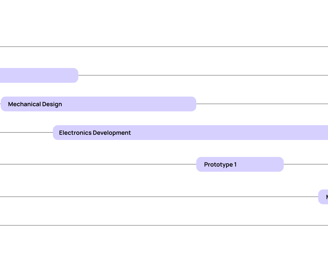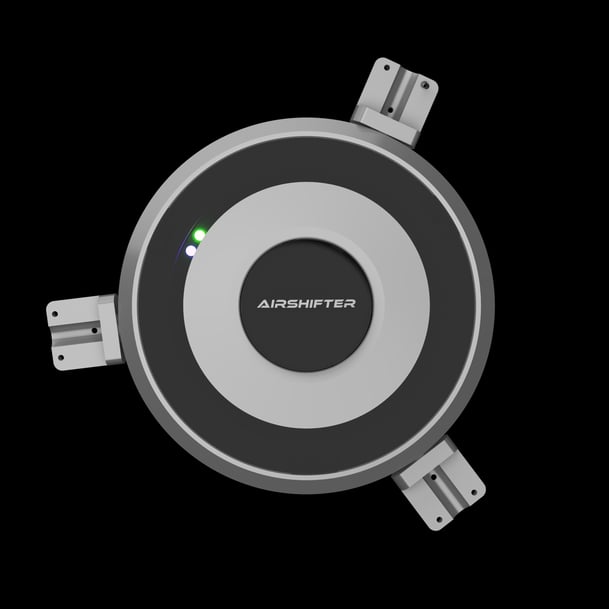AirShifter
Company: Proxgy
Role: Project Lead
Team Credits: 3 Members (1 Designer, 1 Mechanical Engineer, 1 Electronics Engineer)
Timeline: June 2024 - Aug 2024
Variable-Pitch Ceiling Fan with Integrated Purification


The Airshifter is an advanced ceiling fan designed to revolutionize traditional airflow systems by incorporating variable pitch blades, automatic room size detection, and built-in air purification and sterilization technology. The project was completed within a 2-month timeline, involving a team of three experts in design, mechanical engineering, and electronics. The design process covered initial technology research, CAD modeling, FEA/FEM simulations, prototyping with actual materials, and developing a custom RF remote for full functionality control. The result was a fully functional, market-ready prototype successfully sold to a leading electronics company.
Overview
Problem Statement
Traditional ceiling fans lack modern functionality, especially in adapting to different room sizes, improving air quality, or offering customizable airflow. To address this gap, the challenge was to design an innovative ceiling fan with a variable pitch mechanism that can automatically adjust to room size, while integrating air purification and sterilization features. The goal was to create a multi-functional, user-friendly product controlled by a remote, providing enhanced comfort and efficiency, suitable for modern home and commercial spaces.
"A ceiling fan that tackles the limitations of traditional ceiling fans by combining adaptive airflow, air purification, and ease of control in one versatile, modern solution."


2 Months(Not to scale)
Device Ideations


Project Timeline
Rough visual presentation of the whole timeline from brief to delivery.
Technology Research
In our technology research, we explored various mechanisms to enable the variable pitch angle for the ceiling fan. We investigated solutions like gear mechanisms, actuators, and even magnetic systems to control blade movement. Considering cost-efficiency and practicality, we developed a hybrid mechanism using actuators, which proved to be both innovative and cost-effective. This approach was entirely novel in the realm of domestic ceiling fans, leading to a patented design.














CFD Analysis







Prototyping
The initial phase of AirShifter’s development involved creating a 3D-printed SLA prototype, which served as a critical proof of concept to test the design, size, and core mechanics. This prototype allowed us to verify the fan’s proportions in a real-world setting and provided an early opportunity to assess how well our envisioned rotatable blade mechanism functioned.
Using the prototype, we conducted initial tests to refine the electronic components and assess alignment with our functional requirements. Each adjustment and observation informed the next stage of engineering, guiding us in enhancing both the mechanical functionality and electronic systems.
To optimize AirShifter's airflow performance, we conducted detailed Computational Fluid Dynamics (CFD) analyses, modeling a 10x10 room setup complete with typical furniture arrangements. This setup allowed us to simulate real-world conditions and evaluate how changes in blade angle and RPM affected airflow distribution and velocity.
Our CFD testing involved multiple simulations at various blade angles and RPMs, revealing critical insights into how air moves across different areas of the room. These findings informed further adjustments to AirShifter’s design, ensuring that each change in blade angle delivers maximum air circulation and improved cooling efficiency.






User Interaction
AirShifter’s user interface is designed for intuitive and immediate control, with LED indicators providing real-time feedback on various functions. The LED panel on the fan visually communicates fan speed, displaying different levels for a quick at-a-glance understanding. Each mode—Auto, Turbo, and Eco—has a dedicated LED indicator, allowing users to seamlessly switch between settings based on their preferences or room conditions. Additional LEDs signify the activation of the air purifier and UVC sterilization functions, ensuring users are aware when these health-enhancing features are in operation.
The fan remote is equally user-friendly, featuring a clean layout with dedicated buttons for each function, enhancing accessibility and ease of use.
Speed 1
Speed 2
Speed 3
Speed 4
Speed 5
Speed 6





Auto Mode
Turbo Mode
Eco Mode
Air-purifier & UVC
Speed 6 + Air-purifer & UVC
Designing the remote layout involved multiple iterations focused on usability, intuitive control, and aesthetic cohesion with the fan. Explored different button arrangements, icons, and overall shapes, aiming to streamline access to core features like airflow adjustment, HEPA purification, and lighting controls. Each iteration was tested to ensure the remote design enhanced user experience, making advanced functions easy to locate and operate without overwhelming the user.
Final Prototype
The final prototype of AirShifter showcases its fully realized form, crafted with actual production-grade materials such as aluminum for the top and bottom housings, blades, and connecting shafts, alongside high-quality plastic canopies and trim elements. This build allowed us to verify the integration of materials, design, and electronic components, resulting in a refined and polished product.










AirShifter’s LED interactions and operating modes are designed for intuitive functionality and ease of use. In Auto Mode, the fan leverages a built-in LiDAR sensor to detect room size, adjusting airflow automatically to maintain optimal comfort. Turbo Mode maximizes airflow for rapid cooling in larger or warmer spaces, while Eco Mode conserves energy by adjusting airflow to a more efficient level. Activating Air Purifier mode turns on an internal fan and UVC light, purifying and sterilizing the air as it circulates. LED indicators provide clear, real-time feedback for each mode, ensuring a seamless and user-friendly experience.




The pitch angle adjustment feature of AirShifter has been successfully implemented with the actual ceiling fan blades. Unlike a standard ceiling fan, AirShifter can change its blade pitch angle in response to different operating modes, allowing it to generate significantly enhanced airflow when needed.






Impact & Results:
During air purification testing, AirShifter reduced the room's AQI from 999 to 50 within 90 minutes, with further improvement over time.
Secured a ₹90 crore deal and a one-year production development period for final refinements and mass production.
Completed the project from concept to fully functional prototype in just two months, marking it as Proxgy’s fastest-executed project.
Learnings:
The AirShifter project provided valuable insights into rapid prototyping, collaborative problem-solving, and the integration of advanced technology within a short timeframe. Developing a functional prototype with complex features—like LiDAR-based airflow adjustments and integrated air purification—taught us the importance of aligning engineering and design efforts closely to streamline development. The project reinforced the value of iterative testing, particularly in areas like airflow dynamics and purification efficiency, to validate design decisions in real-world conditions. Additionally, working under tight deadlines highlighted our team’s ability to adapt quickly, prioritize effectively, and push creative boundaries to deliver a product that meets both user needs and client expectations.
Tools & Technologies
Tools: Miro, Confluence, Figma, SolidWorks, Keyshot, Sketchbook
Technologies: LiDAR, HEPA, Actuator based mechanical-electronics assembly


Thank you!






